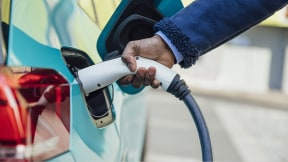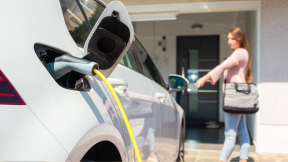How EVs can ease stress on the electric power grid

Quick insights
- EVs can ease stress on the power grid by charging during off-peak hours; however, those time frames could change in the future.
- If drivers charge EVs when renewable energy production is high, charging may not strain the normal operation of the power grid.
- Many EVs use vehicle-to-grid (V2G) technology, allowing them to store and feed energy back into the grid during peak demand times.
New research from Recurrent Auto shows that electric vehicles (EVs) are expected to make up 50% of new car purchases by 2030, Footnote 1Opens overlay and that means more cars are relying on the electric grid—rather than gasoline—to power up. The natural question becomes: What can we do to make sure the grid can handle it? There are steps you can take with your own EVs to manage potential strain on the electrical power grid.
Charging at the right time of day
Planning when you charge your electric vehicle is one way to reduce stress on the power grid.
When fewer EVs were on the road, the prevailing wisdom was to charge during “off-peak hours”—when the least amount of electricity is being used by other sources. This is typically at night, when people are asleep, and many businesses are closed. In fact, the U.S. Energy Information Administration (EIA) even provides a precise definition of “off-peak hours” as between 11 p.m. and 7 a.m. Footnote 2Opens overlay In some cases, local utilities have even provided incentives or discounts to consumers who charged their EVs overnight.
However, if EV purchases continue to grow as expected, charging at night may not be the best option. According to a recent Stanford study that forecasted the energy demand by 2035 in the western United States, Footnote 1Opens overlay researchers recommend that drivers move to daytime charging—most commonly done at work or public charging stations. This is because a significant increase in nighttime charging could require grid operators to:
- Use more sources of energy at night: Sources that are otherwise “off” because demand is otherwise low. Turning on more sources of energy at night could increase both pollution and costs.
- Dip into stored energy: Energy that is typically reserved for high-peak hours—for example, in hot weather when more people run their air conditioning. In general, power is stored when supply exceeds demand, and then we use that stored power when demand exceeds supply. This helps normalize grid operations so additional sources of energy aren’t required.
Considering your energy source
Each region of the country has a different mix of energy sources—coal, nuclear, solar, wind, and more. The type of energy sources used in your area may impact the best time of day to charge.
For example, in states with a high percentage of solar power, energy supply is typically highest in late mornings and early afternoons—when the sun tends to be shining. This creates an ideal window to charge your EV.
In states that use a lot of nuclear energy—which is “always on,” unlike other sources of energy that are either naturally intermittent (like solar and wind) or can be turned on/off (like coal and gas)—nighttime charging might still be the best option.
Ultimately, it’s best to be aware of how your region generates its energy, and to check with your local energy provider to determine the best times to charge—and if they offer any discounts during certain hours.
Responsive power grid technology
Another way to protect the power grid is through charging technologies. Many EVs sold in the United States have a technology called vehicle-to-grid, or V2G, integration, which allows energy to flow back and forth between the power grid and the EV’s battery.
V2G integration helps protect the power grid’s stability and resilience by storing excess energy and then pushing it back to the grid during periods of high energy demand. So, for example, when the sun is shining, a lot of solar energy is generated but isn’t necessarily needed on-the-spot. That excess energy supply can be stored in batteries and deployed later in the day when energy demand peaks.
Using a similar principle, the energy in your EV’s battery can be deployed to the grid during high-demand periods and then returned later. This kind of responsive system helps prevent outages and blackouts by balancing energy sources during fluctuating energy production and demand.
To ensure drivers always have enough battery charge to get them where they need to go, V2G integration requires drivers to schedule when they want their car to be connected to the V2G system.
In summary
By being mindful of when and where you charge your EV, and investing in new technologies, consumers can help protect the power grid. Depending on where consumers live in the country, charging during different times of the day can help reduce stress on the grid. Many electric companies also offer discounts on charging during hours that are better for energy supply and sustainability. Technologies, like V2G integration, also protect the grid by flowing energy between EV batteries and the grid to balance fluctuating energy supply and demand.
To learn more about EVs, visit chase.com/EV.



